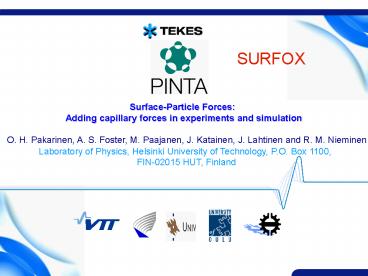Analytic formulas for basic shapes PowerPoint PPT Presentation
1 / 22
Title: Analytic formulas for basic shapes
1
(No Transcript)
2
- Analytic formulas for basic shapes
- Numerical calculations with volume elements for
realistic tip or particle shapes and roughness.
Principle K. Cooper et. al. J. Colloid Interface
Sci. 234 (2001)
3
- AFM image of the real
- SiO2 surface
4
- AFM image of the real
- SiO2 surface
- Align tip randomly,
- optionally allow to relax
- Calculate the adhesion force
5
- Without relaxation poor results
6
- With relaxation the deviations usually match
nicely with experiments
- Without relaxation poor results
7
- With relaxation the deviations usually match
nicely with experiments
- Without relaxation poor results
8
- Capillary force arises from the pressure
difference, caused by surface tension, in the
water meniscus between two bodies. The meniscus
condenses from ambient humidity. - Also a direct surface tension component in the
force.
- Present if humidity exceeds 10-20
- The strength of the force is dependent on
shapes, sizes and materials of the bodies.
9
- The experimental humidity dependence
SiO2 sphere on TiO2 and SiO2 surfaces
10
- Code solving the exact (non-circular) meniscus
profile numerically from the Kelvin equation has
been developed. - Line elements are arranged so that
- the meniscus has the correct surface
- curvature at each point
- Any axially symmetric particle shape
- can be studied
- The capillary force can be calculated
- from the profile using the
- Young-Laplace equation.
11
- The capillary force becomes humidity dependent
for nanoscale objects - - standard approximation
- for spheres fails
- Increasing tip-sample separation induces a
non-zero offset humidity, below which the
meniscus does not form.
12
- The capillary force becomes humidity dependent
for nanoscale objects - - standard approximation
- for spheres fails
- Increasing tip-sample separation induces a
non-zero offset humidity, below which the
meniscus does not form.
13
- The capillary force humidity dependence has been
studied for different tip profiles and tip-sample
separations. - Tip profile determines the maximum force humidity.
14
- Also two different models of pull-off have been
studied. - The models are found to produce very different
predictions of the capillary force.
- Equilibrium approximation
- is valid in most processes.
- (Shown by MD-simulations,
- D. Seveno, J. De Coninck,
- Langmuir 20 (2004) 737)
15
(No Transcript)
16
(No Transcript)
17
(No Transcript)
18
(No Transcript)
19
(No Transcript)
20
(No Transcript)
21
(No Transcript)
22
(No Transcript)

